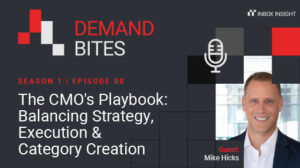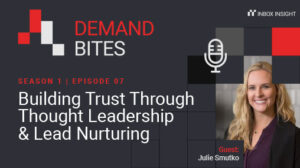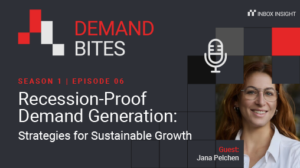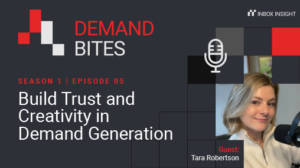Developing a demand generation strategy that will support your marketing objectives is all about leveraging the tools you have at your disposal. It means going beyond the standard every day and developing new tactics and strategies to dig deeper into the data and insights you have available to you. But successfully leveraging B2B intent data to help inform your decision making can often seem like an impossible task.
In this webinar, we’re going to look at:
-
- What is B2B intent data?
-
- Reading the digital footprint of your audience
-
- How to use intent signals to understand content consumption
-
- How marketers are using intent data
-
- The 5 types of intent data
-
- Third-party vs first-party intent signals: what’s the difference?
-
- How to use intent signals in your mutlichannel strategy
-
- Using intent signals for lead scoring
Full transcript below.
Reading time: 22 minutes
(00:02)
Hello, thank you for joining us for the Science of Demand Generation: B2B Intent Data. My name is Ross Howard. I’m Head of Product at Inbox Insight and today I’m going to talk to you about how you can deploy intent data in your B2B marketing campaigns to maximize your results.
(00:19)
The reason we’re calling this the Science of Demand Generation is we’d like to take a stricter scientific method approach to demand generation, and we’d like you to do so as well in the coming year as you look at ways that you can make your demand generation more predictable and have a method behind it so that you can maximize the revenue that you get back in your funnel, and that you can prove how it’s working each step of the way.
(00:43):
Now, I like to start all of these webinars with a quote. As science is the theme today there’s a quote from Leonardo da Vinci and it says;
“Science is the observation of things possible, whether the present or past… the knowledge of things which may come to pass…”
What that means for us on our scientific journey with demand gen is that we also need to start with observation. We need to look at what our audience is doing and try and get inside their head to predict how they will act next. And the tool to do that is intent data. That’s what gives you the insight and the answers to those questions that you start to develop as you observe your audience’s behavior.
What is intent data?
(01:27)
Intent data is a combination of data types that you can use to create a picture of the buyer’s journey based on online behaviors. So even in a complex B2B sale with multiple individuals involved, you can aggregate this data together and understand why they’re doing what they’re doing and change their behaviors to increase their likelihood of becoming a potential buyer. Sounds good, doesn’t it? So how does it work?
To take a step back and look at the context of why we do this, it’s widely understood in content marketing that by producing valuable content for your audience to consume, they’ll be more likely to trust your brand and buy from you. But what if you could measure all of those content interactions and what was happening?
We surveyed 250 senior leaders working in IT across the US and UK recently, and we asked them which topic areas they were most interested in researching and which types of technology they intend to invest in, and they line up almost directly.
(02:30)
So people researching IT security are going to buy information security later the same year 79% to 76%, cloud computing 76% to 72%, development 66% to 63%. What that shows is there’s a causal link. People know that in order to make a large purchase to deal with their role, what they need to do is put the time in and put the research in first.
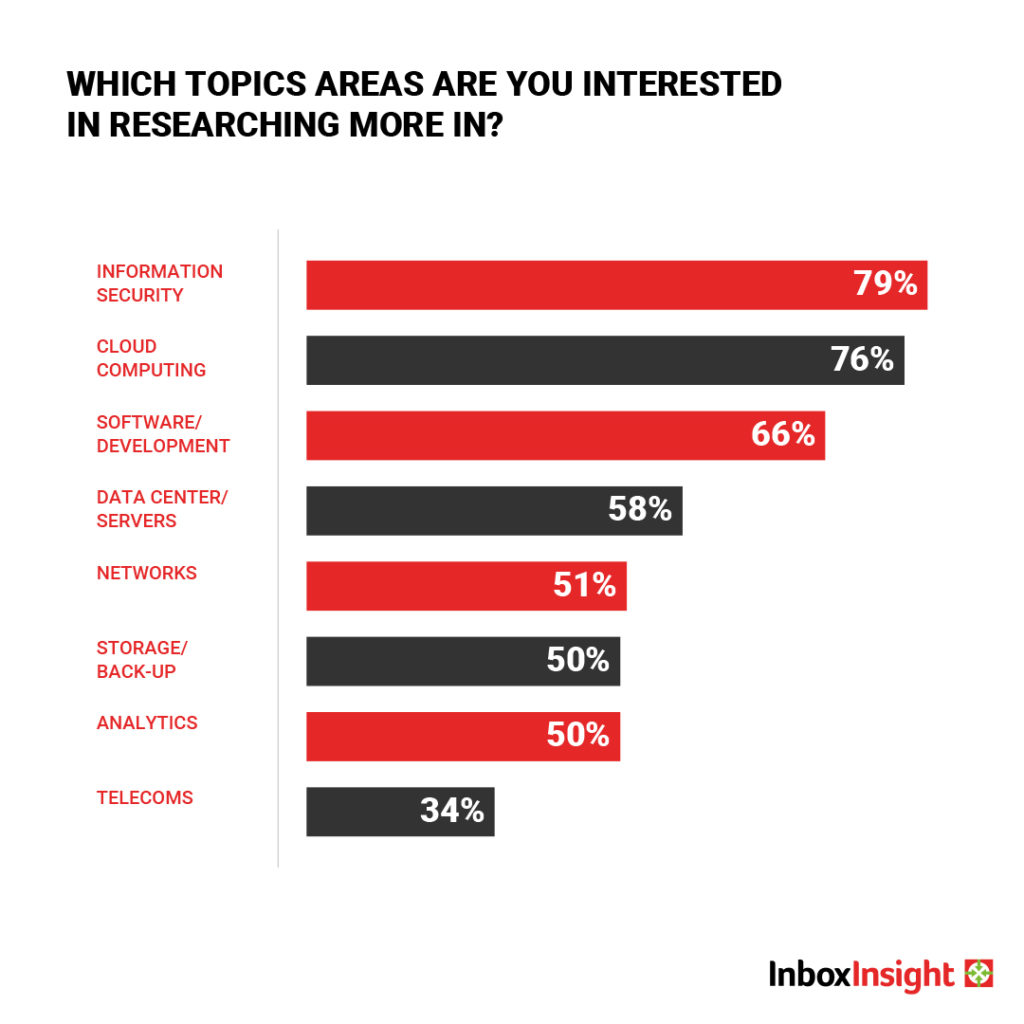
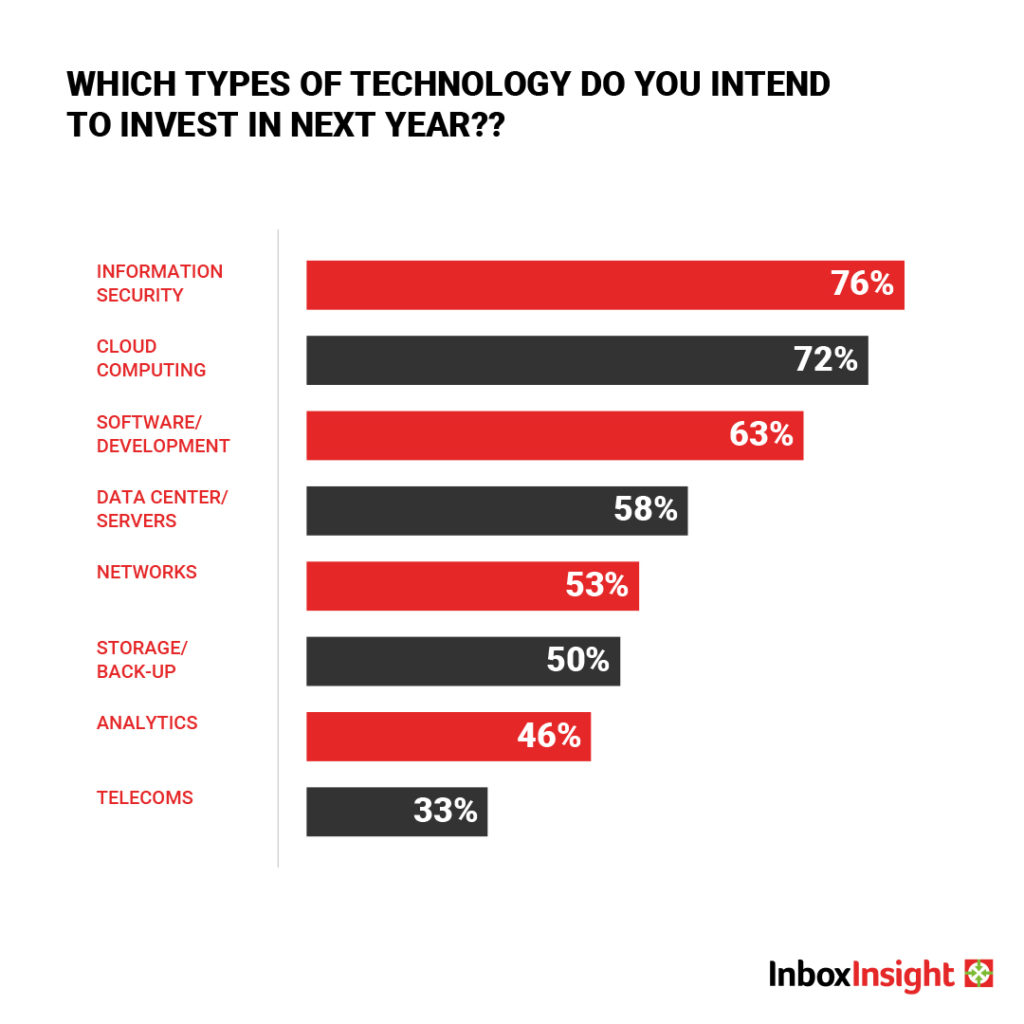
But we also combine that view with our audience of around 800,000 senior IT professionals using bespoke analytics and tracking their content consumption. And what that lets us do is make sure that’s actually correct. We can measure those signals that they leave when people are engaging with content and compare it to what they say they’re interested in.
(03:16)
A third of respondents to the same buyer behavior study told us that they consume more than 10 pieces of content before committing to a buying process. So while they’re going around different vendors, while they’re trusting their colleagues to advise them, while they’re coming to virtual events like this one, they’re consuming multiple pieces of content around the same topic areas.
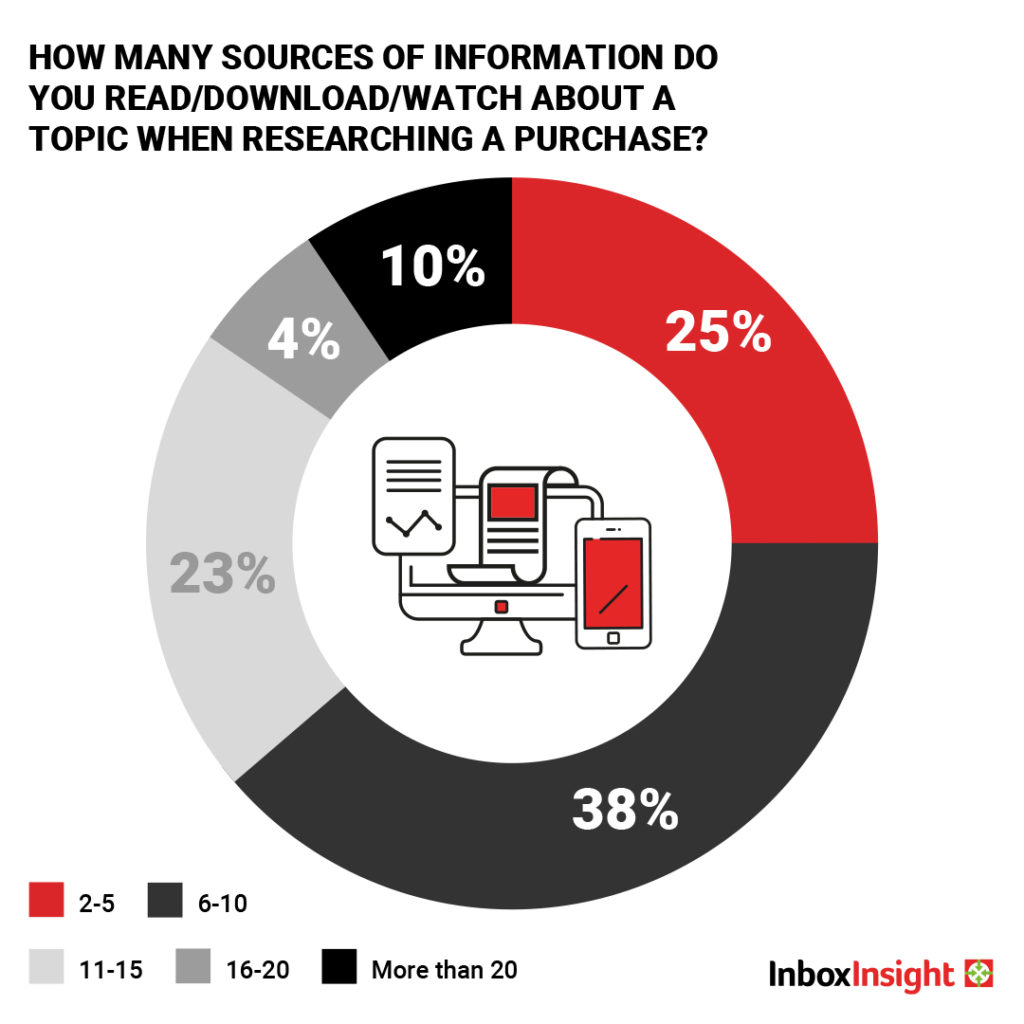
What that lets us do is understand a little bit about the patterns of their research so that we can use that intent data later to segment and market to those people and understand what they’re interested in. In fact, 84% of the same study told us that they’re involved in more than six technology purchases a year. That’s a lot of research to do.
Just putting those together; 60 pieces of content across the year, that’s the minimum that they’re likely to engage with on all of these topics across multiple different areas. That across the multiple people involved in a decision making unit means that there’s going to be a lot of content consumption happening. There’s going to be lots of people engaging with assets like yours and those of your competitors. If you can understand the data that people leave behind as they do that process, you can move people through the funnel closer to a purchase decision with you.
What do I mean by content consumption?
(04:39)
As people engage with things like your blog, your whitepapers, your webinars, different events, different publisher websites, they’re leaving behind a trail of content journeys. They’re doing this to help expand their understanding and engage with thought leadership and fulfill their obligations as a senior buying decision maker. But in doing so, they’re revealing the things that they’re interested, and we can measure these tags and the categories and the engagements that they leave behind and try and understand what that person cares about the most.
Using these intense signals, as we call them, to create a part of B2B intent data around your brand, you can start to understand who your audience is, how you can interact with them better, and how you can follow up with them to close a deal. So we run insightsforprofessionals.com, which is a content platform full of content, over 4,000 articles, reports, infographics and webinars, and growing across IT, marketing, HR, finance and management, which includes things like sales and feed management and procurement.
(05:47)
What we know from gathering together all of this content and having a professional audience that consumes it is that you can use the insight of the interactions of that platform to drive more content engagement because you understand the user’s needs and you can provide more relevant content in a sequence.
So you gather a bit of information about the audience, you understand which individuals and pots and pockets are interested in which topics, and you feed those topics back to them to help ingrain those behaviors and get them more engaged with each of the brands that they’re researching from.
Eventually they continue through the funnel and purchase from one of those vendors, but at that early research stage, it’s important that your brand is helping those individuals by being as relevant as possible and using the learning to do this. That’s what IFP is based on. We’ve got nearly 1,000 brands and experts on the platform and that puts us in a unique position to try and track and aggregate some of this knowledge and talk to you about it today.
The rise of intent data
(06:47)
The rise of intent data analytics is broadly established. Almost everybody in digital marketing and B2B marketing that I speak to has quite a sophisticated understanding of analytics and they know that they need it to understand their customers. What they don’t necessarily do is use analytics in a practical way.
They have to draw a line that’s often quite a difficult part to manage in terms of stakeholders and technology to try and make use of all the things that they learn. What we can do with intent data is help bridge that gap and help segment and target audiences that are directly related to the content that you produce so that you can begin interacting with them sooner.
(07:32):
We ran a different research study earlier in this year about B2B intent data to our audience of 200 B2B marketers, all of our peers, and we asked them if they were currently using intent data in their organization. 99% of people said they were. So this is definitely in play, it’s throughout our industry and our ecosystems is something that people are doing. When we asked them how mature they were in their strategy, they told us that they were well established or fully synchronized 80% of the time. So this is something that people are confident in, they believe that they got set up and they believe that they’ve got working in their organization.
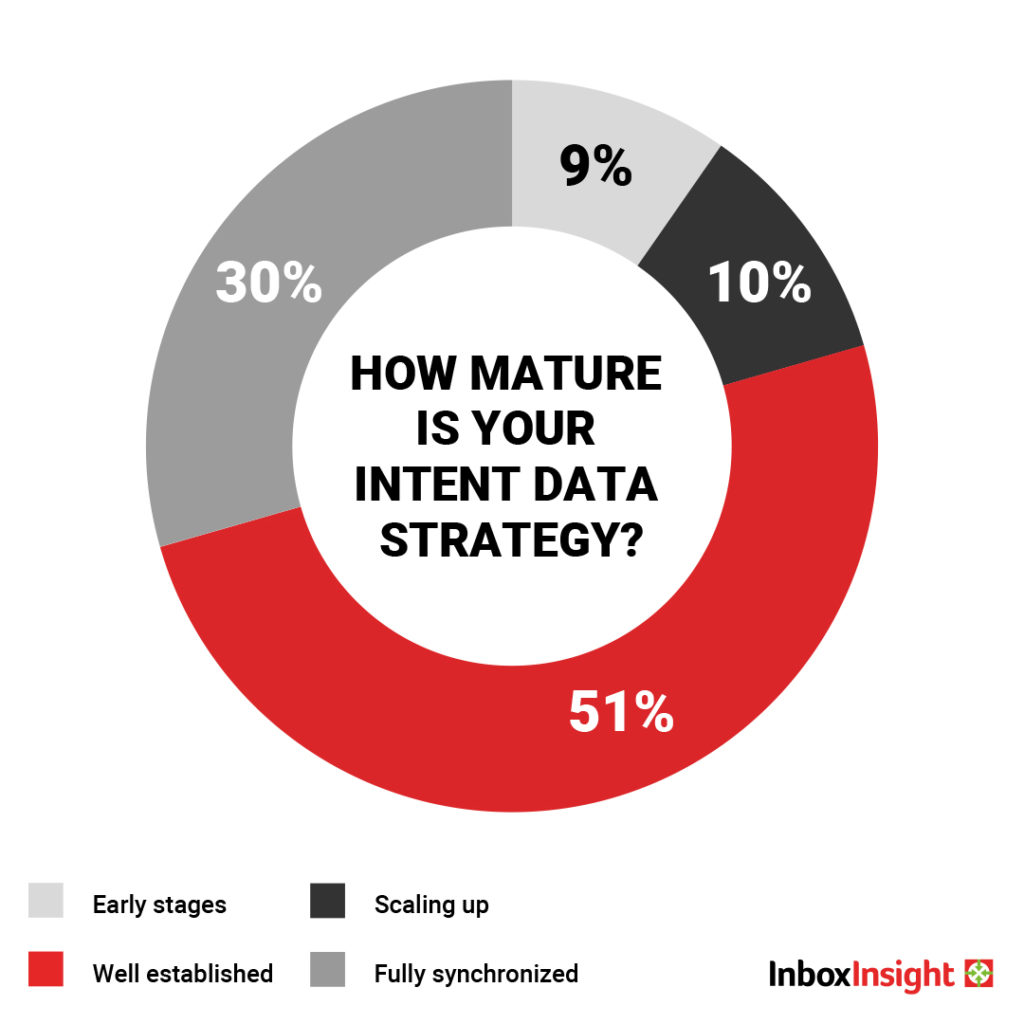
How marketers are using B2B intent data
(08:14)
So how are they using it? How is everybody else doing this? 62% of them told us that they were using intent data to build and develop their buyer personas. 58% told us that they were identifying early buyer interest using intent, and then 57% told us that they were using lead scoring and prioritizing specific accounts. Those are all important objectives when using intent data, but it has broader implications than all of these things and can be used in conjunction. What we noticed throughout the survey is that not all users were using intent for every purpose. So even though you have a large swath of the market using this, they’re not using it in every use case that they possibly could.
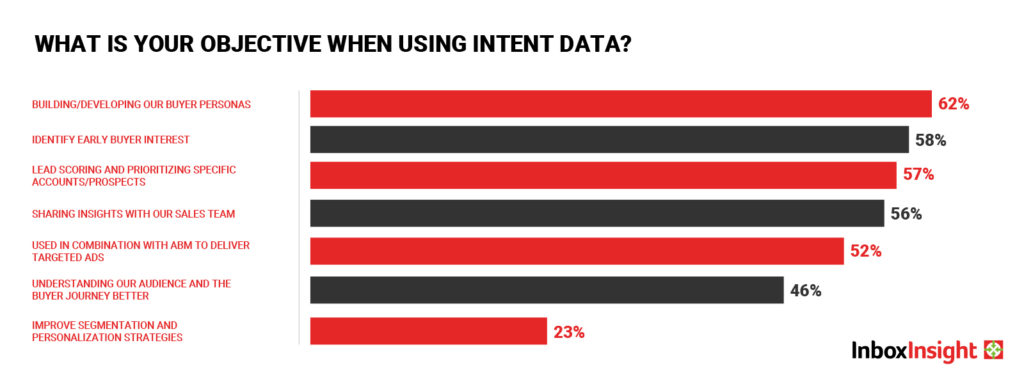
(09:00)
One of the things that we’ve seen from discussions of ROI is that 99% told us that they have increased conversion rates or increased return on investment directly by using intent data. So this is in the market and everybody’s doing it and everybody is seeing clear benefits, but it’s sporadic. The B2B marketing industry knows intent should be used, they’re deploying it, it’s got huge promise and huge benefits, but they’re not necessarily getting the most from it. They’re using it in some of the use cases where they can and not others.
And when we asked them what their most significant challenge was when it came to B2B intent data, it was actioning on the insights gathered from intent data at 64%. 63% – coming a close second – there was combining it with their marketing strategy to deliver targeted ads and then 56% told us it was ensuring their sales team are utilizing intent information they provide.
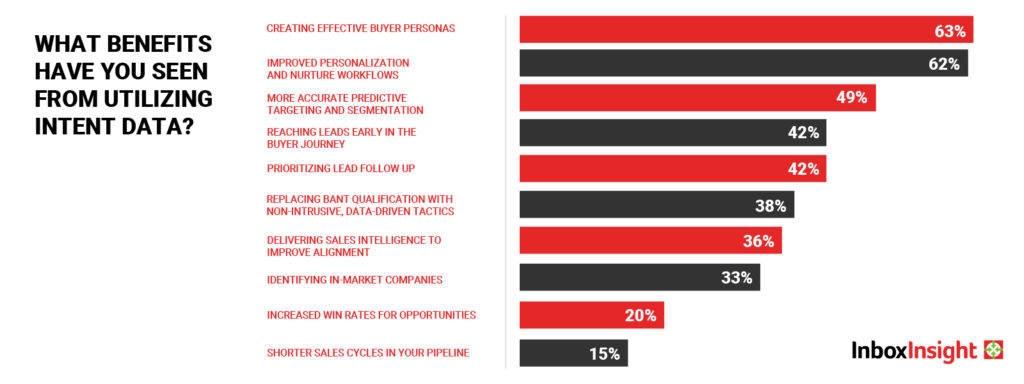
What we can summarize from that is you should be using intent data for audience insight to map your audience based on their behavior, to increase your use of multi-channel so that you can reach the audience with your content wherever they are and to help prioritization so that you can pass that across to your sales team and convert in-market buyers. And the data that’s out there and available to you in your space very likely can do all of those things.
Segmenting audience based on intent data
(10:35)
One of the first things that you should tackle when thinking about audience insight is how to create audience segments or target account lists based on intent behaviors. Taking a look at account-based marketing approaches at the moment, there’s lots of talk of working with a vendor or working with a CRM specialist to see who your best accounts are, who spends the most money with you, who’s the best type of company for you to go after, and then looking up similar companies available in your total addressable market and going after those first. That is practical, absolutely fine. We’ve seen it work very well for some of our clients, but you can take that step further.
By using third-party intent sources, you can build up highly qualified audiences because as well as knowing what’s the right types of companies to go after, you can find out of those companies which ones already engage with high amounts of content on your particular topic area. What that lets you do is see who’s researching the right topic within your target accounts right now, and that gives you a much higher likelihood of being able to immediately weaponize that data for the sales team and to focus your marketing efforts on those companies that are already in-market for what you are offering as they’ve proven that they’re consuming content on the same topic.
(11:54)
You can then take this nugget of companies that are already in-market for what you do. They’re researching it and they’re the right people to buy from and start to make lookalikes of those and see if you can notice similarities or use the predictive modeling available to say, how can we widen our targeting but keep the core reason why these people would buy from us so that we can find more of the same, reaching out to those people maybe before they’ve begun researching in earnest, but they share all of the characteristics that would make them important for you to go after.
That lets you build a different type of target account list, that will let you, not cannibalize your initial one but find new greenfield accounts that are highly likely to be interested in what you’ve got to say. That type of audience insight is available and depending on the types of content you have, probably a couple of clicks away from the right vendor.
The five types of intent signals
(12:44)
When I say intent data, there are different types of intent data and I’m just going to pause now and go through a few of the different ones before we discuss how we can use them. We categorize it at Inbox Insight into five types of intent signals.
1. Search intent
So type one is searching, so that might be keyword and query data. Lots of people think Google is the be all and end all there. It’s definitely very important and they’ve made a stake in talking about search intent for a long time, but actually search intent could be searches on your own website, searches on publisher websites, some intent signals where somebody is seeking the right information and they’re demonstrating that through any type of search query.
2. Browsing intent
(13:27)
The second type of intent data is browsing intent data. Now that’s normally tracked through cookies which are attached to an anonymous user and the cookies can then be categorized by the type of content the person was consuming. So there’ll be buckets of different types of cookie data on different topic areas that you can tap into and use for segmentation learning and targeting based on those browsing behaviors.
3. Action-based intent
(13:53)
The third type of intent data that we talk about is action-based intent data. These are specific, measured actions against types of activities that a user can take. So that might be clicks on websites or on emails, that might be engagement with video content like this, how long they’ve spent watching it, it could be shares that they’ve taken. All of these signals against a user demonstrate purchase intent or research intent and interest in the topic area.
4. Firmographic intent
(14:21)
The fourth type of intent data is firmographic intent data. By firmographic I mean company data and that’s the data that we see when an entire organization might be taking an action. Itcould be that they’ve just received funding or that they’re hiring for certain types of skills, which means they’re likely to have certain technologies in place or be on the verge of a big project. That shows intent for an entire company to move in a certain direction and it’s often combined with and happens at the same time as lots of individual users searching for different types of content and consuming that content.
5. Predictive lookalike modeling
(14:56)
And the fifth type is predictive lookalike modeling. So that is where we start to understand all of the B2B intent data signals of the first four and combine them in different ways to look for who is making some similar actions elsewhere so that we can go and find people ahead of time to start earlier in front and start engaging them with your content. Who are the types of people that have high intent and who are the types of people that look like they might have high intent in the future? Can we get in front of them earlier to help engage them?
Third-party vs first-party intent data
(15:29)
Now I mentioned third-party intent data already. I think it’s important to categorize what I mean by that. We tend to split B2B intent data into first-party intent and third-party intent.
First-party intent is information gathered about your prospects and clients from all across your digital touchpoints. That’s your own website, your own analytics software, your own CRM and marketing automation signals. These are things within your ecosystem that you have access to as a brand. That data stored and used is first-party when you use it.
First-party intent data is very effective and very transparent. You’ve likely gathered it via consent already if you’re following all of the right rules under GDPR and other consent frameworks and privacy frameworks, so you can get a lot of access and information available to you. And if you start to combine that with a slightly more advanced approach, if you have ad tech in place or a data management platform, you can start connecting that to your CRM, so you can have details like where they work, which salesperson of yours they talked to, what their email address is connected to, engagement with different types of website content, and the amount of time they’ve spent consuming things like that because you can own that all within your own ecosystem.
(16:51)
Third-party data is intent data which is gathered on digital touchpoints on other people’s websites such as publishers or content platforms like IFP. Third-party intent is very useful at highlighting new prospects that you’re not aware of yet.
So when you look at your first-party intent, you’ve got a lot of individuals coming to your website consuming content and some of them letting you know who they are through lead capture. All of that research has probably been prefaced by research on other platforms or other places where they could be consuming content.
If people are consuming at least 10 pieces of content before they make a buying decision, it’s likely not all of that consumption is with you. And if you tap into third-party intent sources, you can start to access some of those signals that are going on elsewhere and use them within your insight that you’re gathering and within your targeting as well.
(17:46)
Now when we surveyed the audience of B2B marketers, we talked to them about which approach they were using and actually 55% said that they were using a combined approach. When we dug into that and asked them which of those sources did they rely on the most, 75% said first-party, which is unsurprising because you have access to all the tools yourself, but if only 25% are really relying on third-party signals, they could be missing out on all of that information that everybody else has about their prospects and potential customers that they’re not currently using to get an advantage when they’re looking for new prospects to go after.
Using B2B intent data signals in a multichannel strategy
(18:22)
We’ve spoken about insight. Now let’s speak about multichannel. Let’s understand how we can use intent data to help deliver the right messages to the audience in the right way. Even though 99% of us are using intent data, when we looked at which channels it was being used in, the majority told us that they were using it in email nurture and workflows. Only 23% were using it as part of their outbound calling with their SDR teams. Only 54% we’re using it in programmatic display, which is one of the key places where you can deploy pots of cookie data to deliver the right ads and drive the right traffic for you.
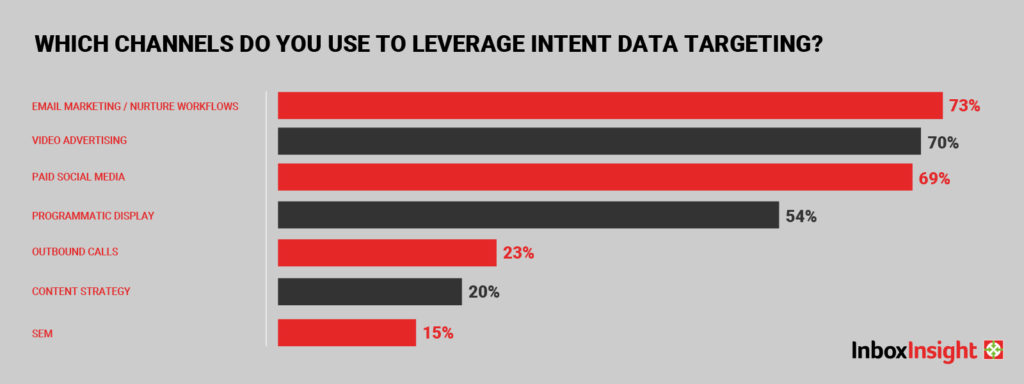
So really what we see is a sporadic approach across the market where people aren’t getting the maximum amount of value from intent data even though they know of it and they’re using it in some of the right places.
(19:11)
When we look at an intent data journey of an individual, it’s very much a case of trying to understand and use third-party against the anonymous users that you haven’t got as leads yet. So before a user is known to your brand directly, you can use third-party intent to track the interests they’re browsing and re-target those individuals with more of the same topic from your brand so that they can start to engage with your content when they’re already interested in it.
We can deploy against that through channels like social, website and programmatic to help deliver content in a near native way to help engage people as they travel around and we’re using cookie data to track them.
(19:51)
Once you’ve captured a lead and they move into your system as first-party data as well, we don’t need to switch those channels off or stop communicating with the user in that way. We do want to keep nurturing them in all of those places, but we can also add first party intent signals to understand what they’ve done in email, what they’ve done on your website, what they’ve done speaking to your SDRs or your sales team, and if they’re engaging with any follow up sequences. This will help drive conversions and push people through the funnel to help complete that buyer journey sooner as you combine the value of both first and third-party.
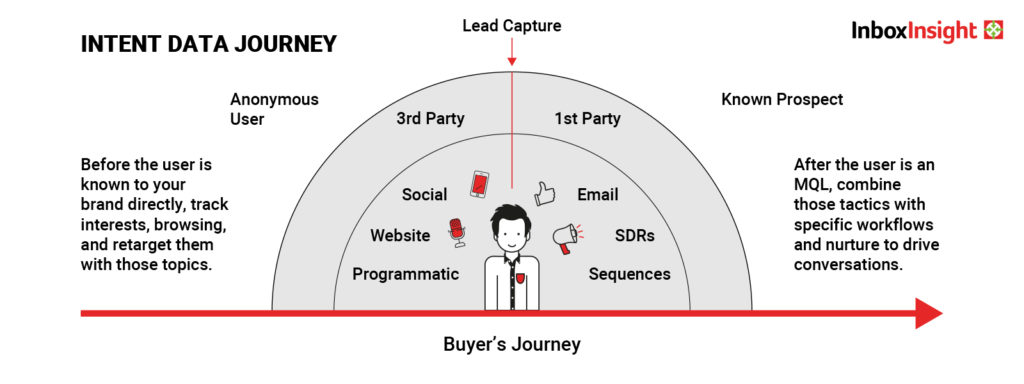
What other channels could you be using your B2B intent data in?
1. Content creation
(20:27)
Content creation is the first point of call when utilizing B2B intent data, often as you start to understand what content your potential customers are engaging with and start to think about how you can create your own content and deliver your own messages that will help tap into that need.
2. Programmatic advertising
(20:50)
Leveraging first and third-party intent data to target users with display and video in programmatic can help you be hyper-relevant to a hard-to-identify B2B audience at scale and help reach individuals that look like those, even pushing that strategy out further to help get brand awareness and drive interest in the topic area in using the learning from those tools to help maximize the relevant audience that you are possible to reach.
3. Social media
(21:19)
If you are using paid social, you can use all of these same tactics with the classification of cookie data against audiences that you’ve engaged with or connecting it to your first-party data that you have in your own system to understand how to drive engagement across social channels into a very specific audience.
4. Email marketing
(21:39):
Email marketing is an incredible way to deploy your B2B intent data in both your prospect marketing or your newsletters. As you start to understand which topics your potential mailing list subscribers are interested in, you can categorize them and start recommending content that’s most relevant to them based on previous content they’ve engaged with.
So setting up triggers in your own workflows, but also understanding which content they’re engaging with in other channels and using that to drive them into the right subsequent workflow. Not just email after email after email, but channels interacting with each other. When they click on something in one, you understand their intent, you use that intent to send them a triggered email.
5. Website personalization
(22:20):
Website optimization and personalization is another fantastic way to use intent. If you can understand the topics that an individual is engaging with and how ready they are to buy, you can customize the landing page you send them to or use some tools; CMSs will even customize the copy on the page that’s shown to them depending on the signals that they receive when the person lands on the page. Really clever stuff.
What’s next? Sales intelligence
(22:44):
You have insight about your audience, you’ve driven them to your site using multichannel, now what? I would like to say here that we need to forget sales and marketing alignment and we need to think about sales intelligence.
I often think a lot of focus in sales and marketing alignment is put on persuading sales of the value of the leads that you’re sending over, especially if they’re higher up the funnel or earlier stage engagement where you want to drive brand recognition and get in the consideration phase, but actually you’re having a hard time getting senior reps to follow up on those marketing qualified opportunities.
With intent data being passed to sales early and often, you can clearly show that the prospect is highly engaged and has intent to buy and you don’t need to negotiate with that sales team to get them engaged with that content. You can provide them the intelligence to say, “Look, this person’s already engaging, you should focus on them.”
(23:43):
What that does is let you play a support role and utilize things like lead scoring based on intent data rather than just based on that individual’s first-party actions to prioritize the accounts and lead follow-up so they’re spending their time on the people that are most likely to buy from them. That often means feeding information to sales in the right way.
You can use lead mapping in your CRM and marketing automation platforms connected to your analytics or to different vendors that you are using to give a history with each lead so that you can see the engagement that a prospect has taken through the content and pass that directly to the sales reps. That might be something like the number of assets they’ve engaged with, the type of content they’ve engaged with, the number of site visits they’ve taken, the time that they’ve spent on that or other webinars.
(24:30):
I’m not speaking today about how to do that in any specific software as often our customers and our clients have lots of different marketing automation tools and different tech stacks in play. I’ve even seen some homegrown systems that have been created by blue chip tech brands to help them do this, but the important takeaway is trying to provide that information so they have it at a glance and can start to use this data as it passes through to them.
Utilize lead scoring based on intent signals to improve your lead follow-up
(24:56)
What we also want to look at is scoring the leads so that you can help send those lists over or send those notifications over to the sales director or the person in charge of following up those leads so that they know which companies to focus their time on.
One way this is split is implicit data about the company and user activities, so the behavior intent of that individual. If somebody has visited a blog page, downloaded a whitepaper, or registered for a webinar, we are talking about their behavior. If somebody is in an industry where we have a good case study or is a senior level job title or their company has over a certain number of employees or has a certain type of technology already installed, then that’s implicit data that you can hold as firmographic intent.
By combining the scores of both of those, you can start to realize who’s a really good fit for your company and who’s really engaged with your content and start to use those signals separately and together to change your follow-up.
(25:55):
Lead scoring is built into most solutions. You can combine that with intent so that when you are passing across this information, it’s in a familiar framework that the sales team like to use and the system wants to use, but it’s taking advantage of all this information that you can gather from elsewhere and all of the interactions that you’ve harvested throughout the prospect’s journey with you so far, you can then feed that score into a prioritization model.
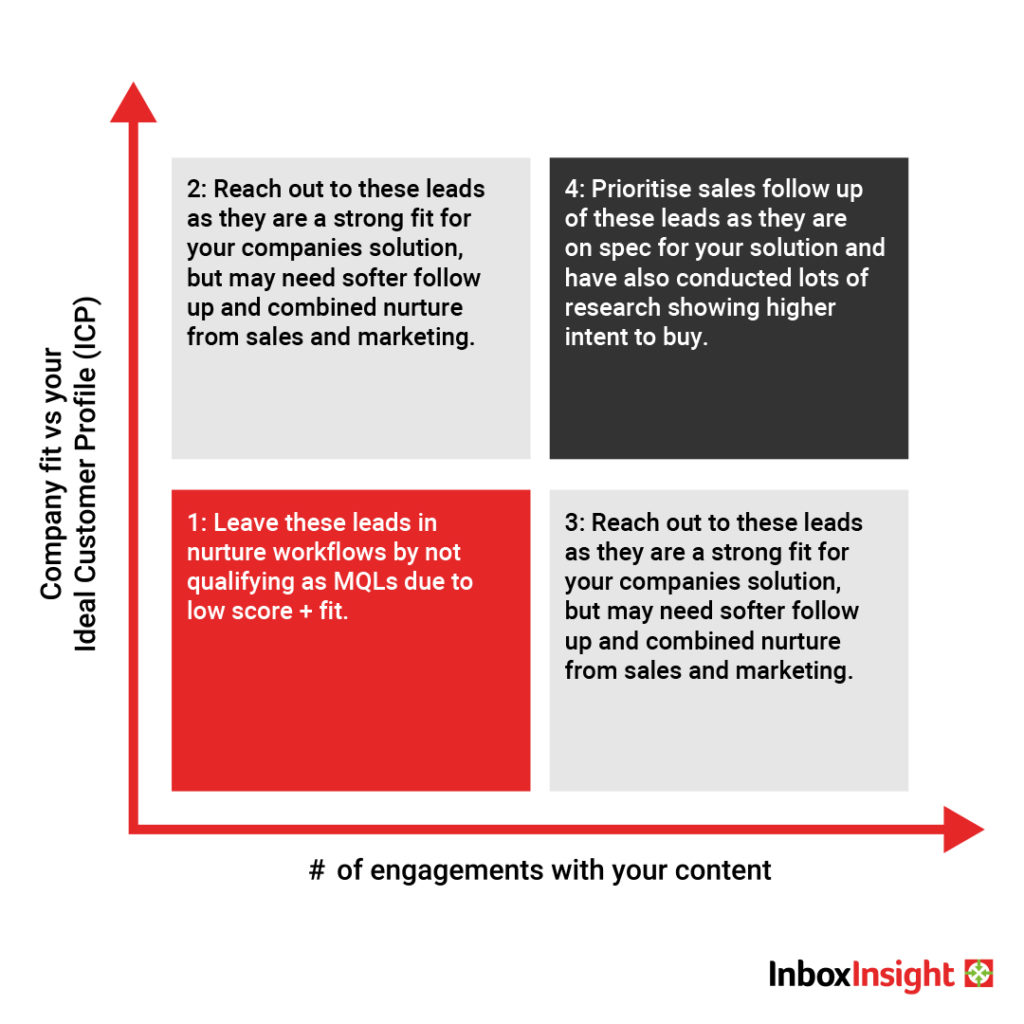
(26:19):
It’s very simple. We’re just thinking about, is this a good fit for my ideal customer profile and are they engaged? If they have a high fit, if they’re a really good company but they’re not yet that engaged, you want to call sooner, engage with them sooner with your marketing materials, but offer content and a soft sell approach to increase the amount of engagement and intent that that decision maker is showing you. If they’re low fit for your company but they’ve got high content engagement, that’s when you may want to sit back slightly and not send your sales team off to contact them, but let that person nurture themselves and come to you in a more of an inbound approach.
(26:58):
If they are both high fit for your company and high engagement, and even if you have other individuals from the same organization that have the same level of engagement, that’s a really hot opportunity. That’s the type of thing that you need to be prioritizing to your sales team and giving them visibility of early and often and potentially following up with a more senior sales representative rather than a BDR or business development person who’s just their send emails.
(27:26):
The other side of this is knowing which content to send somebody. If you are going to send your sales team out to speak with a prospect that’s engaged with your content and has high intent, you should be talking to them about the right topic, and if you’re using the audience insight that you have, you should be sending them out armed with the content that’s about the same topic that the person’s already engaged with.
If I’ve been reading about data centers nonstop and I have loads of intent around that topic area and somebody approaches me with a generic qualification call, I’m less likely to engage than if they approach me with the latest research you have on a data center purchase. You’re using the intent that you have about me to deliver a relevant and key message that’s important to me.
(28:08):
Another way to do that and combine that with your other channels is to think about nurture streams that are combined with sales and marketing teams working together about the topic area that you want to speak about.
Say I come onto your website or I come through a publisher’s website and I’m reading about data centers, you want to target my intent data with more ads around the data center content that you are leading with at the moment.
When I engage with that piece of content, I need to be fed into a stream where I’m going to receive more of the same, not only from your marketing automation and your newsletters, but through your remarketing ads, through programmatic, through social, and through your sales team.
All of that combined means that I’m more likely to progress that purchase with you because I start to trust you and start to see the impact that you could have on my career and my project that I need to run because you understand my needs and you’re feeding me relevant content sooner.
(29:00):
There are tools available as well to automate this process. We found that clients often have some sales enablement tools, maybe some outreach or prospecting tools combined with their CRM already, but we would suggest that marketing teams take a hand in that and try and connect that back to their view of other nurture that they’re doing and provide sales with the tools and templates they need to have that intelligent first touchpoint on follow up, either making templates and suggesting the content to follow up depending on the stream that you pass through to sale.
Thank you very much for your time
(29:27):
Thank you for joining our webinar, the Science of Demand Generation: B2B Intent Data. I hope that was useful and please, if you are watching this on the B2B Marketing Expo, visit our virtual stand or hang around. We’ve got people that that can answer Q&A questions for you. And if you’re watching this on demand, I’d encourage you to check out www.inboxinsight.com and sign up for the newsletter and check out all the rest of our content there. Thanks for your time.


